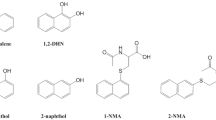Summary
Ambient and biological monitoring of hexane exposure were repeatedly carried out in 14 female shoe makers. Airborne hexane (Ci-H) was measured in 4-h samples collected by a diffusive method. Urinary spot samples were collected before, during (at noon), and at the end of a work shift. 2,5-Hexanedione (2,5HD) in urine collected at noon was poorly related to morning Ci-H. End-of-shift 2,5HD were also poorly related to afternoon air samples. The correlation was still relatively low when end-of-shift 2,5HD was related to 8-h TWA Ci-H (r= 0.44; P<0.01 on a linear scale, and r-0.58, P< 0.01 on a log-log scale). End-of-shift 2,5HD levels estimated on the basis of pre-shift values using a mathematical model were much higher (2.3 times on average) than those experimentally measured during the study period. Owing to its relatively long half-time, 2,5HD seems to be influenced not only by current exposure, but also by hexane absorbed during the day(s) preceding sampling. The lack of a sampling strategy may account not only for inconsistencies between environmental and biological data, but also for a possible misuse of biological monitoring when utilized for risk assessment. Despite sometimes poor correlations with Ci-H, 2,5HD may still be preferred to other indicators as a marker of effective internal dose. A sampling strategy should ensure that measured values are representative of the individual risk for adverse effects.
Similar content being viewed by others
References
Ahonen I, Schimberg RW (1988) 2,5-hexanedione excretion after occupational exposure to n-hexane. Br J Ind Med 45:133–136
Bartolucci GB, De Rosa E, Gori G, Ceccarelli S, Clonfero E, Saia B (1990) Biomonitoring of exposure to n-hexane and risk of neurotoxicity. 23rd International Congress on Occupational Health, Montreal, 22–28 September 1990, p. 540 (abs.)
Bernard A, Lauwerys R (1986) Present status and trends in biological monitoring of exposure to industrial chemicals. J Occup Med 28: 558–562
Castleman BI, Ziem GE (1988) Corporate influence on threshold limit values. Am J Ind Mad 13: 531–560
Fedtke N, Bolt HM (1986) Detection of 2,5-hexanedione in the urine of persons not exposed to n-hexane. Int Arch Occup Environ Health 57: 143–158
Governs M, Calisti R Coppa G, Tagliavento G, Colombi A, Troni W (1987) Urinary excretion of 2,5-hexanedione and peripheral polyneuropathies in workers exposed to hexane. J Toxicol Environ Health 20: 219–228
Imbriani M, Ghittori S, Pezzagno G, Capodaglio E (1984) n-Hexane urine elimination and weighted exposure concentration. Int Arch Occup Environ Health 55: 33–41
Iwata M, Takeuchi Y, Hisanaga N, Ono Y (1983a) A study on biological monitoring of n-hexane exposure. Int Arch Occup Environ Health 51: 253–260
Iwata M, Takeuchi Y, Hisanaga N, Ono Y (1983b) Changes in n-hexane metabolites in urine of rats exposed to various concentrations of hexane and to its mixture with toluene or MEK Int Arch Occup Environ Health 51:1–8
Kawai T, Yasugi T, Mizunuma K, Horiguchi S, Uchida Y, Iwami O, Iguchi H, Ikeda M (1990) Dose-dependent increase of 2,5-hexanedione in the urine of workers exposed to n-hexane. Int Arch Occup Environ Health 62: 403–408
Kawai T, Yasugi T, Mizunuma K, Horiguchi S, Uchida Y, Iwami O, Iguchi H, Ikeda M (1991) 2-Acetylfuran, a confounder of 2,5-hexanedione determination in urine. Int Arch Occup Environ Health 63: 213–219.
Mutti A, Falzoi M, Lucertini S, Arfini G, Zignani M, Lombardi S, Franchini I (1984) n-Hexane metabolism in occupationally exposed workers. Br J Ind Med 41: 533–538
Perbellini L, Amoros DM, Cardona Llorens A, Giuliari C, Brugnone F (1990) An improved method for analyzing 2,5-hexanedione in urine. Br J Ind Med 47:421–424
Perbellini L, Bartolucci GB, Brugnone F, De Rosa E, Valentini F (1985) Il 2,5-esandione nel controllo biologico dell'esposizione professionale ad esano. Med Lav 76:35–43
Perbellini L, Brugnone F, Faggionato G (1991) Urinary excretion of the metabolites of n-hexane and its isomers during occupational exposure. Br J Ind Med 38:20–26
Perbellini L, Mozzo P, Olivato D, Brugnone F (1982) Metabolic interference between n-hexane and toluene in vivo and in vitro. Int Arch Occup Environ Health 50:351–358
Roach SA and Rappaport SM (1990) But they are not thresholds: A critical analysis of the documentation of threshold limit values. Am J Ind Med 17:727–754.
Author information
Authors and Affiliations
Rights and permissions
About this article
Cite this article
Mutti, A., Bergamaschi, E., Ghittori, S. et al. On the need of a sampling strategy in biological monitoring: The example of hexane exposure. Int. Arch Occup Environ Heath 65 (Suppl 1), S171–S176 (1993). https://doi.org/10.1007/BF00381334
Issue Date:
DOI: https://doi.org/10.1007/BF00381334




